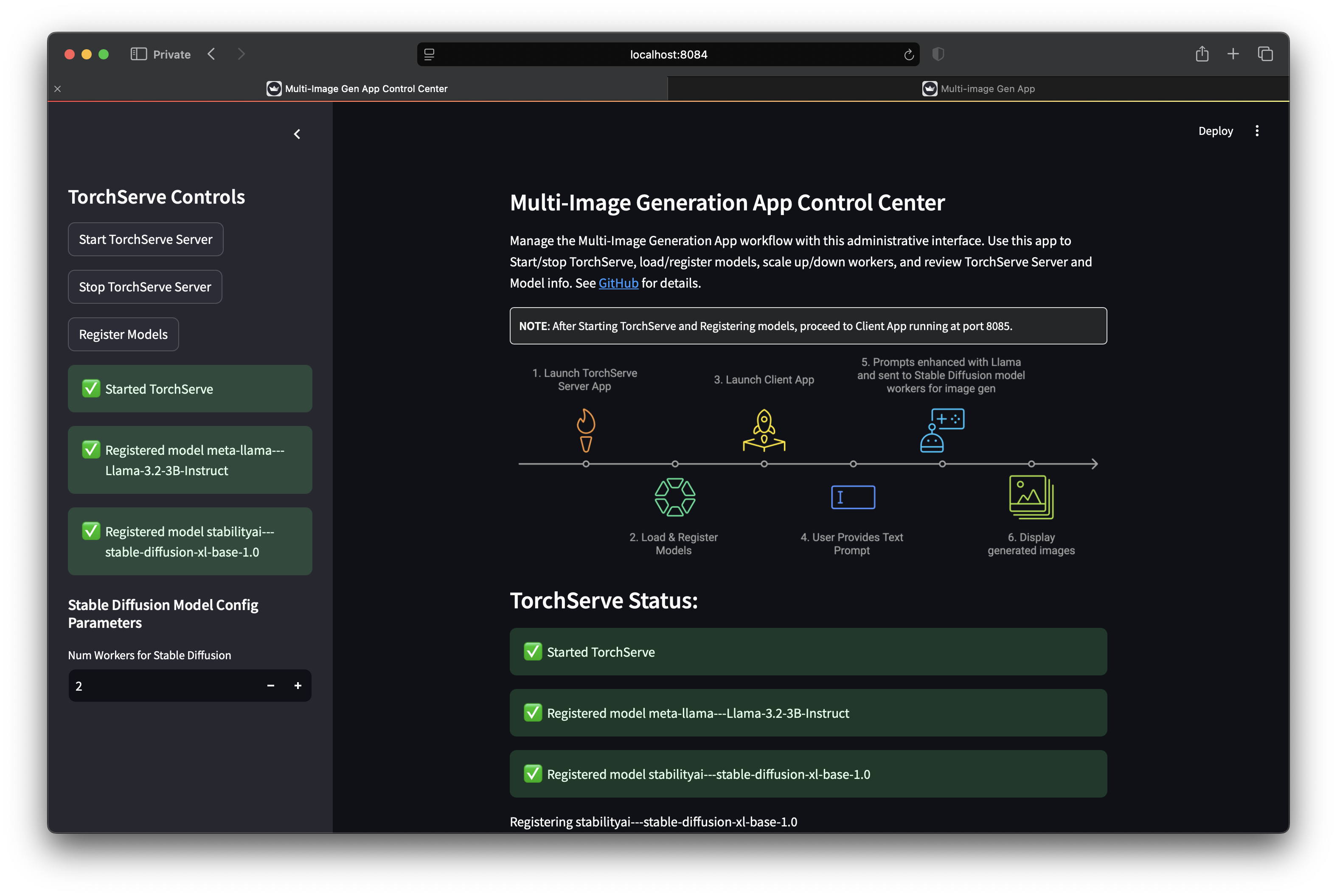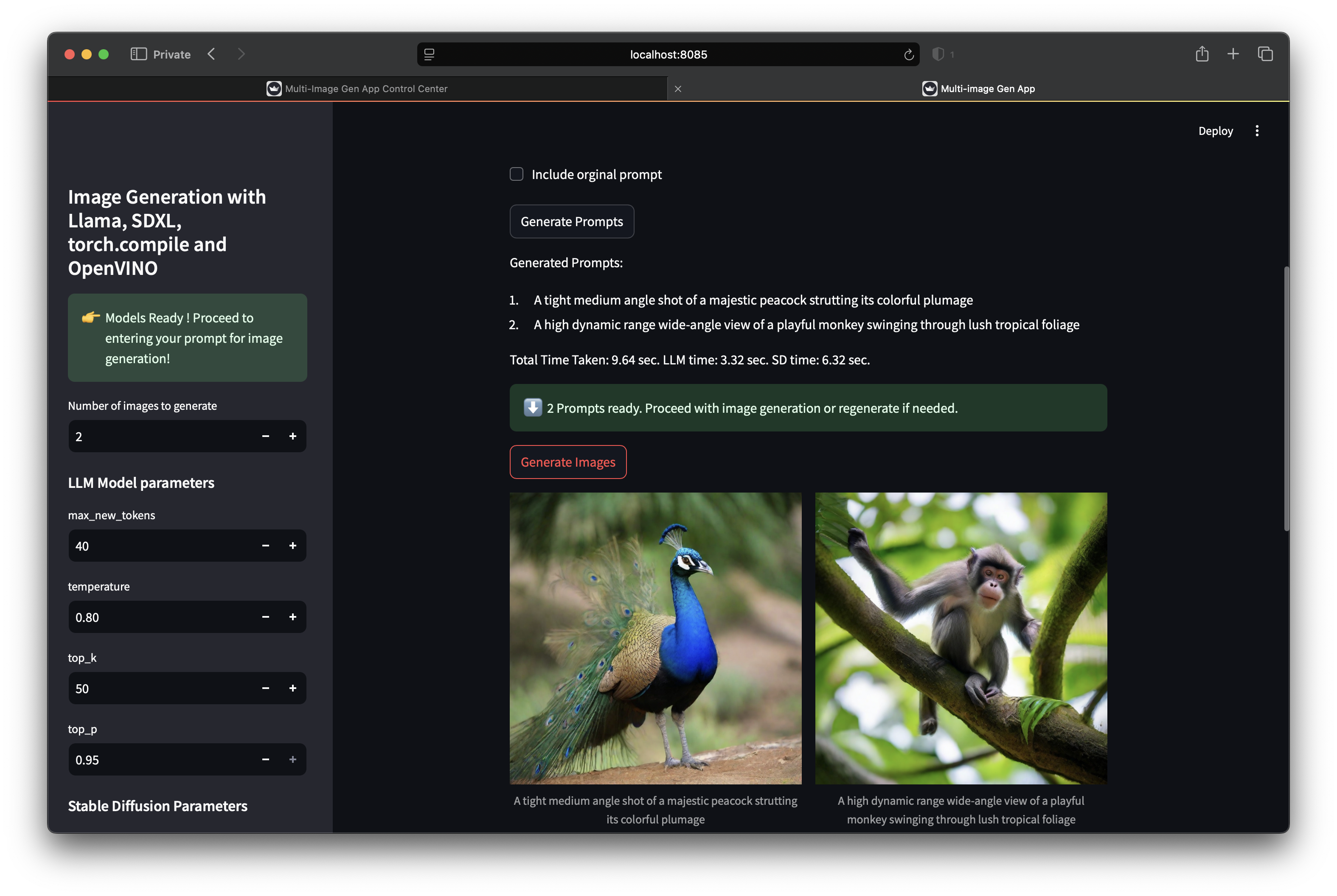Multi-Image Generation Streamlit App: Chaining Llama & Stable Diffusion using TorchServe, torch.compile & OpenVINO¶
This Multi-Image Generation Streamlit app is designed to generate multiple images based on a provided text prompt. Instead of using Stable Diffusion directly, this app chains Llama and Stable Diffusion to enhance the image generation process. Here’s how it works:
The app takes a user prompt and uses Meta-Llama-3.2 to create multiple interesting and relevant prompts.
These generated prompts are then sent to Stable Diffusion with latent-consistency/lcm-sdxl model, to generate images.
For performance optimization, the models are compiled using torch.compile using OpenVINO backend.
The application leverages TorchServe for efficient model serving and management.

Quick Start Guide¶
Prerequisites:
Docker installed on your system
Hugging Face Token: Create a Hugging Face account and obtain a token with access to the meta-llama/Llama-3.2-3B-Instruct model.
To launch the Multi-Image Generation App, follow these steps:
# 1: Set HF Token as Env variable
export HUGGINGFACE_TOKEN=<HUGGINGFACE_TOKEN>
# 2: Build Docker image for this Multi-Image Generation App
git clone https://github.com/pytorch/serve.git
cd serve
./examples/usecases/llm_diffusion_serving_app/docker/build_image.sh
# 3: Launch the streamlit app for server & client
# After the Docker build is successful, you will see a "docker run" command printed to the console.
# Run that "docker run" command to launch the Streamlit app for both the server and client.
Sample Output of Docker Build:¶
ubuntu@ip-10-0-0-137:~/serve$ ./examples/usecases/llm_diffusion_serving_app/docker/build_image.sh
EXAMPLE_DIR: .//examples/usecases/llm_diffusion_serving_app/docker
ROOT_DIR: /home/ubuntu/serve
DOCKER_BUILDKIT=1 docker buildx build --platform=linux/amd64 --file .//examples/usecases/llm_diffusion_serving_app/docker/Dockerfile --build-arg BASE_IMAGE="pytorch/torchserve:latest-cpu" --build-arg EXAMPLE_DIR=".//examples/usecases/llm_diffusion_serving_app/docker" --build-arg HUGGINGFACE_TOKEN=hf_<token> --build-arg HTTP_PROXY= --build-arg HTTPS_PROXY= --build-arg NO_PROXY= -t "pytorch/torchserve:llm_diffusion_serving_app" .
[+] Building 1.4s (18/18) FINISHED docker:default
=> [internal] load .dockerignore 0.0s
.
.
.
=> => naming to docker.io/pytorch/torchserve:llm_diffusion_serving_app 0.0s
Docker Build Successful !
............................ Next Steps ............................
--------------------------------------------------------------------
[Optional] Run the following command to benchmark Stable Diffusion:
--------------------------------------------------------------------
docker run --rm --platform linux/amd64 \
--name llm_sd_app_bench \
-v /home/ubuntu/serve/model-store-local:/home/model-server/model-store \
--entrypoint python \
pytorch/torchserve:llm_diffusion_serving_app \
/home/model-server/llm_diffusion_serving_app/sd-benchmark.py -ni 3
-------------------------------------------------------------------
Run the following command to start the Multi-Image generation App:
-------------------------------------------------------------------
docker run --rm -it --platform linux/amd64 \
--name llm_sd_app \
-p 127.0.0.1:8080:8080 \
-p 127.0.0.1:8081:8081 \
-p 127.0.0.1:8082:8082 \
-p 127.0.0.1:8084:8084 \
-p 127.0.0.1:8085:8085 \
-v /home/ubuntu/serve/model-store-local:/home/model-server/model-store \
-e MODEL_NAME_LLM=meta-llama/Llama-3.2-3B-Instruct \
-e MODEL_NAME_SD=stabilityai/stable-diffusion-xl-base-1.0 \
pytorch/torchserve:llm_diffusion_serving_app
Note: You can replace the model identifiers (MODEL_NAME_LLM, MODEL_NAME_SD) as needed.
What to expect¶
After launching the Docker container using the docker run .. command displayed after a successful build, you can access two separate Streamlit applications:
TorchServe Server App (running at http://localhost:8084) to start/stop TorchServe, load/register models, scale up/down workers.
Client App (running at http://localhost:8085) where you can enter prompt for Image generation.
Note: You could also run a quick benchmark comparing the performance of Stable Diffusion with Eager, torch.compile with inductor and openvino. Review the
docker run ..command displayed after a successful build for benchmarking
Sample Output of Starting the App:¶
ubuntu@ip-10-0-0-137:~/serve$ docker run --rm -it --platform linux/amd64 \
--name llm_sd_app \
-p 127.0.0.1:8080:8080 \
-p 127.0.0.1:8081:8081 \
-p 127.0.0.1:8082:8082 \
-p 127.0.0.1:8084:8084 \
-p 127.0.0.1:8085:8085 \
-v /home/ubuntu/serve/model-store-local:/home/model-server/model-store \
-e MODEL_NAME_LLM=meta-llama/Llama-3.2-3B-Instruct \
-e MODEL_NAME_SD=stabilityai/stable-diffusion-xl-base-1.0 \
pytorch/torchserve:llm_diffusion_serving_app
Preparing meta-llama/Llama-3.2-1B-Instruct
/home/model-server/llm_diffusion_serving_app/llm /home/model-server/llm_diffusion_serving_app
Model meta-llama---Llama-3.2-1B-Instruct already downloaded.
Model archive for meta-llama---Llama-3.2-1B-Instruct exists.
/home/model-server/llm_diffusion_serving_app
Preparing stabilityai/stable-diffusion-xl-base-1.0
/home/model-server/llm_diffusion_serving_app/sd /home/model-server/llm_diffusion_serving_app
Model stabilityai/stable-diffusion-xl-base-1.0 already downloaded
Model archive for stabilityai---stable-diffusion-xl-base-1.0 exists.
/home/model-server/llm_diffusion_serving_app
Collecting usage statistics. To deactivate, set browser.gatherUsageStats to false.
Collecting usage statistics. To deactivate, set browser.gatherUsageStats to false.
You can now view your Streamlit app in your browser.
Local URL: http://localhost:8085
Network URL: http://123.11.0.2:8085
External URL: http://123.123.12.34:8085
You can now view your Streamlit app in your browser.
Local URL: http://localhost:8084
Network URL: http://123.11.0.2:8084
External URL: http://123.123.12.34:8084
Sample Output of Stable Diffusion Benchmarking:¶
To run Stable Diffusion benchmarking, use the sd-benchmark.py. See details below for a sample console output.
ubuntu@ip-10-0-0-137:~/serve$ docker run --rm --platform linux/amd64 \
--name llm_sd_app_bench \
-v /home/ubuntu/serve/model-store-local:/home/model-server/model-store \
--entrypoint python \
pytorch/torchserve:llm_diffusion_serving_app \
/home/model-server/llm_diffusion_serving_app/sd-benchmark.py -ni 3
.
.
.
Hardware Info:
--------------------------------------------------------------------------------
cpu_model: Intel(R) Xeon(R) Platinum 8488C
cpu_count: 64
threads_per_core: 2
cores_per_socket: 32
socket_count: 1
total_memory: 247.71 GB
Software Versions:
--------------------------------------------------------------------------------
Python: 3.9.20
TorchServe: 0.12.0
OpenVINO: 2024.5.0
PyTorch: 2.5.1+cpu
Transformers: 4.46.3
Diffusers: 0.31.0
Benchmark Summary:
--------------------------------------------------------------------------------
+-------------+----------------+---------------------------+
| Run Mode | Warm-up Time | Average Time for 3 iter |
+=============+================+===========================+
| eager | 11.25 seconds | 10.13 +/- 0.02 seconds |
+-------------+----------------+---------------------------+
| tc_inductor | 85.40 seconds | 8.85 +/- 0.03 seconds |
+-------------+----------------+---------------------------+
| tc_openvino | 52.57 seconds | 2.58 +/- 0.04 seconds |
+-------------+----------------+---------------------------+
Results saved in directory: /home/model-server/model-store/benchmark_results_20241123_071103
Files in the /home/model-server/model-store/benchmark_results_20241123_071103 directory:
benchmark_results.json
image-eager-final.png
image-tc_inductor-final.png
image-tc_openvino-final.png
Results saved at /home/model-server/model-store/ which is a Docker container mount, corresponds to 'serve/model-store-local/' on the host machine.
Sample Output of Stable Diffusion Benchmarking with Profiling:¶
To run Stable Diffusion benchmarking with profiling, use --run_profiling or -rp. See details below for a sample console output. Sample profiling benchmarking output files are available in assets/benchmark_results_20241123_044407/
ubuntu@ip-10-0-0-137:~/serve$ docker run --rm --platform linux/amd64 \
--name llm_sd_app_bench \
-v /home/ubuntu/serve/model-store-local:/home/model-server/model-store \
--entrypoint python \
pytorch/torchserve:llm_diffusion_serving_app \
/home/model-server/llm_diffusion_serving_app/sd-benchmark.py -rp
.
.
.
Hardware Info:
--------------------------------------------------------------------------------
cpu_model: Intel(R) Xeon(R) Platinum 8488C
cpu_count: 64
threads_per_core: 2
cores_per_socket: 32
socket_count: 1
total_memory: 247.71 GB
Software Versions:
--------------------------------------------------------------------------------
Python: 3.9.20
TorchServe: 0.12.0
OpenVINO: 2024.5.0
PyTorch: 2.5.1+cpu
Transformers: 4.46.3
Diffusers: 0.31.0
Benchmark Summary:
--------------------------------------------------------------------------------
+-------------+----------------+---------------------------+
| Run Mode | Warm-up Time | Average Time for 1 iter |
+=============+================+===========================+
| eager | 9.33 seconds | 8.57 +/- 0.00 seconds |
+-------------+----------------+---------------------------+
| tc_inductor | 81.11 seconds | 7.20 +/- 0.00 seconds |
+-------------+----------------+---------------------------+
| tc_openvino | 50.76 seconds | 1.72 +/- 0.00 seconds |
+-------------+----------------+---------------------------+
Results saved in directory: /home/model-server/model-store/benchmark_results_20241123_071629
Files in the /home/model-server/model-store/benchmark_results_20241123_071629 directory:
benchmark_results.json
image-eager-final.png
image-tc_inductor-final.png
image-tc_openvino-final.png
profile-eager.txt
profile-tc_inductor.txt
profile-tc_openvino.txt
num_iter is set to 1 as run_profiling flag is enabled !
Results saved at /home/model-server/model-store/ which is a Docker container mount, corresponds to 'serve/model-store-local/' on the host machine.
Multi-Image Generation App UI¶
App Workflow¶

App Screenshots¶
| Server App Screenshot 1 | Server App Screenshot 2 | Server App Screenshot 3 |
|---|---|---|
 |
 |
 |
| Client App Screenshot 1 | Client App Screenshot 2 | Client App Screenshot 3 |
|---|---|---|
 |
 |
 |
